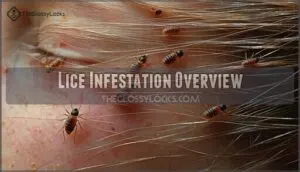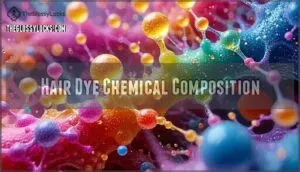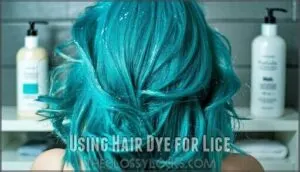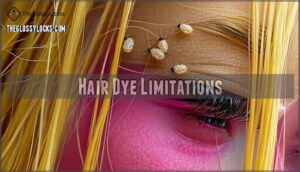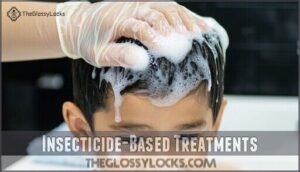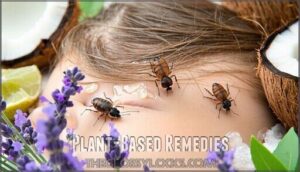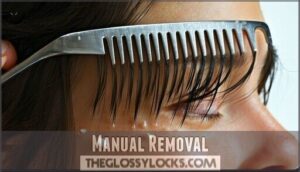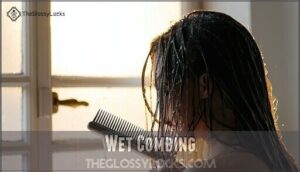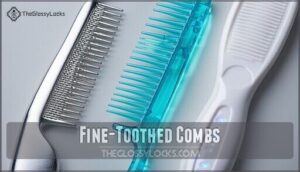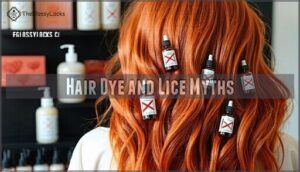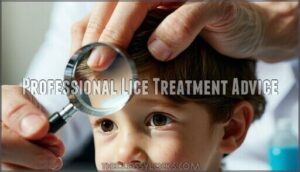This site is supported by our readers. We may earn a commission, at no cost to you, if you purchase through links.
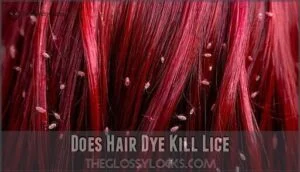
This means the infestation can bounce back before you know it. Plus, dyeing too often can damage your scalp and hair, which isn’t what you want while dealing with lice.
If you’re curious, some people swear by the idea that darker hair dye scares lice, though that’s more myth than fact. For long-term results, consider proven treatments that tackle both lice and nits effectively.
Table Of Contents
- Key Takeaways
- Lice Infestation Overview
- Does Hair Dye Kill Lice
- Hair Dye Chemical Composition
- Using Hair Dye for Lice
- Hair Dye Limitations
- Alternative Lice Treatments
- Lice Removal Methods
- Hair Dye and Lice Myths
- Professional Lice Treatment Advice
- Frequently Asked Questions (FAQs)
- Can lice become immune to hair dye?
- Does hair dye affect lice egg development?
- Are natural dyes safer for lice treatment?
- How often should hair dye be reapplied?
- Can hair dye prevent future lice infestations?
- Can dyed hair prevent future lice infestations?
- How does hair dye interact with lice treatments?
- What role does climate play in lice behavior?
- Are natural hair dyes effective against lice?
- Conclusion
Key Takeaways
- Hair dye may kill some adult lice due to chemicals like ammonia and hydrogen peroxide, but it won’t affect nits, leaving the infestation unresolved.
- Overusing hair dye for lice treatment can irritate your scalp, damage hair, and doesn’t offer a reliable or lasting solution.
- Manual removal with a fine-toothed comb and using proven lice treatments are more effective and target both lice and unhatched eggs.
- Lice don’t care if your hair is dyed; they’re drawn to warmth and the scalp, so prevention requires avoiding direct contact and sharing personal items.
Lice Infestation Overview
Lice are small, blood-feeding insects that live on the scalp, thriving close to the skin.
They spread easily through direct contact with an infested person, making outbreaks common in schools and households.
What Are Lice
Lice are tiny parasitic insects that live on human hair and scalps, feeding on blood to survive.
Tiny parasites thrive on the scalp, feeding on blood to survive, making lice relentless invaders in need of effective elimination.
About the size of a sesame seed, these human parasites are translucent white or brown.
Their life cycle lasts about 30 days, during which they’re busy laying nits (lice eggs), firmly attached to hair shafts.
Understanding lice biology and identification is key to tackling infestations effectively and avoiding repeated outbreaks.
How Lice Spread
Head lice spread quickly, primarily through direct contact with an infected person’s hair, making children especially vulnerable.
Sharing personal items like hats, combs, or headphones rarely spreads lice but isn’t impossible. These parasites are highly contagious and can climb hair shafts to reach the scalp.
Environmental factors like shared spaces don’t directly cause infestations. Prevention methods, like avoiding head-to-head contact and not sharing items, reduce the contagion rate substantially, which is a critical aspect of managing outbreaks.
Lice Symptoms
You might notice a tickling feeling or itch intensity on your scalp—classic signs of a lice infestation.
A persistent tickling sensation or intense scalp itch could signal an unmistakable sign of a lice infestation.
Scalp irritation, caused by their bites, leads to relentless scratching, which can disrupt sleep and worsen the discomfort.
Visual signs include spotting tiny, moving head lice or their nits, glued to hair shafts near the scalp.
Scalp tenderness can also occur due to the irritation and inflammation caused by the infestation.
These lice symptoms often appear first in children, who unknowingly spread them through close contact.
Does Hair Dye Kill Lice
Many people wonder if hair dye can effectively eliminate a lice problem.
While anecdotal evidence suggests permanent hair dye containing ammonia and hydrogen peroxide may kill some adult lice, scientific research doesn’t fully support this claim.
The chemical exposure from dye products can affect scalp health and might kill some mature parasites, but dye effectiveness against lice is limited.
Most importantly, hair dye doesn’t penetrate nit shells, allowing eggs to survive and hatch later.
For complete lice removal, you’ll need a treatment combination approach rather than relying solely on hair dye as a lice treatment, and understanding that hair dye is not a standalone solution is crucial, as it does not provide complete lice removal.
Hair Dye Chemical Composition
You’ll find that permanent hair dye contains potent chemicals like ammonia and hydrogen peroxide, which disrupt the lice’s respiratory system while potentially damaging their exoskeleton.
These active ingredients work by altering protein structures, similar to how they transform your hair color, but their effectiveness against lice remains scientifically unconfirmed despite anecdotal success reports.
Ammonia Effects
Almost all permanent hair dyes contain ammonia, a powerful alkaline chemical that opens your hair cuticle for color penetration.
When considering ammonia for lice treatment, you should understand it disrupts protein bonds but doesn’t guarantee effectiveness against lice resistance.
The chemical poses inhalation risks and may cause chemical burns or scalp damage with prolonged exposure.
While ammonia’s toxicity might affect some lice, it’s not specifically formulated as a lice treatment and can’t be relied upon for complete eradication.
Permanent dyes contain ammonia and peroxide, which can strip natural pigments.
Hydrogen Peroxide Role
While ammonia opens the hair cuticle, hydrogen peroxide takes on the heavy lifting in your dye.
This oxidizing agent strips natural color by breaking down melanin pigment and facilitating dye-hair shaft interaction.
At typical concentration levels (3-12%), it creates oxidative stress that damages lice but can’t penetrate nits (lice eggs).
Your scalp may also suffer damage from prolonged exposure, causing dryness and weakening hair’s structure.
Hair dye effects include potential treatment synergies when combined with specific lice remedies.
Other Chemicals
The chemical arsenal in hair dye contains several potent compounds beyond ammonia and peroxide that might affect lice resistance patterns.
- Paraphenylenediamine (PPD) can cause allergic reactions while possibly disrupting lice exoskeletons
- Resorcinol functions as an endocrine disruptor in humans and potentially in parasites
- Toluene, a neurotoxin, might damage lice nervous systems similarly to permethrin or malathion
Unlike dedicated treatments containing benzyl alcohol or pyrethrins, these chemicals weren’t designed for lice control, explaining their inconsistent results as a treatment option.
Using Hair Dye for Lice
You’ll find that permanent hair dye containing ammonia and hydrogen peroxide may suffocate some adult lice, though it won’t penetrate the protective coating of nits attached to hair shafts.
While not medically approved for lice treatment, the application process resembles standard hair coloring procedures but requires additional safety precautions due to potential scalp irritation and chemical exposure.
Application Process
The chemical components in hair dye now come into play during the application process.
While not designed for lice treatment, here’s how you’d apply hair dye when targeting these unwanted visitors:
| Step | Action | Time Required | Safety Note |
|---|---|---|---|
| 1 | Strand test | 24 hours prior | Prevents allergic reactions |
| 2 | Dye preparation | 5 minutes | Use gloves, ventilate area |
| 3 | Root touch-ups first | 10-15 minutes | Focus on nape and ears |
| 4 | Full saturation | 30-40 minutes | Guarantee complete coverage |
Post-Dyeing Care
After applying hair dye as a lice treatment, proper post-dyeing care is essential for both lice elimination and scalp health. The chemicals in hair dye can leave your scalp vulnerable.
For effective post-treatment care, consider the following steps:
- Rinse thoroughly to remove all chemical residue
- Apply a hydration boost with deep conditioning
- Monitor for any scalp irritation or allergic reactions
- Continue checking for lice daily for two weeks
Remember, color maintenance shouldn’t be your priority – ensuring complete lice removal is the main goal. Some individuals may experience itchy scalp issues after dyeing.
Safety Precautions
After completing the dyeing process, it’s time to focus on staying safe.
When using hair dye for lice, always wear protective gloves to minimize chemical exposure. Never apply to broken skin, as this increases risk of allergic reactions and chemical burns.
Keep products away from eyes and test on a small area first. For children, these safety precautions are even more important due to their sensitive scalp health.
Remember, hair dye isn’t designed for this purpose, and it’s crucial to follow these guidelines to avoid any potential harm, especially considering the chemical exposure.
Hair Dye Limitations
While hair dye may kill some adult lice through its chemical components, it won’t penetrate the protective shell of nits attached to your hair shafts.
You’ll still need to manually remove eggs and consider the potential side effects of scalp irritation, allergic reactions, and hair damage when using dye as a lice treatment.
Ineffective Against Nits
While hair dye may affect adult lice, it completely fails against their eggs.
Nits have protective egg casings that prevent chemicals from penetrating, allowing the hatching cycle to continue uninterrupted.
When treating a lice infestation, remember these critical facts about nit resilience:
- Nits are cemented to hair shafts with a powerful adhesive
- Each missed nit can restart the entire infestation process
- Eggs hatch within 9-10 days regardless of hair dye application
This is why re-infestation risk remains high after dyeing, as the presence of nits ensures the continuation of the infestation cycle.
Potential Health Risks
Using hair dye as a lice treatment comes with significant health concerns.
You’re exposing yourself to substantial risks that extend beyond mere inconvenience.
| Risk Factor | Severity | Prevention Steps |
|---|---|---|
| Allergic reactions | Moderate to severe | Patch test 48 hours before |
| Chemical burns | Moderate | Follow instructions carefully |
| Hair damage | Mild to severe | Deep condition afterward |
| Cancer risks | Low but concerning | Limit frequency of exposure |
| Toxicity | Potentially severe | Never ingest; avoid eye contact |
Scalp Irritation
Repeated hair dye applications can trigger severe scalp irritation when treating lice infestations.
Your skin may develop redness, itching, and flaking as harsh chemicals interact with an already stressed scalp. Chemical burns aren’t uncommon, especially for those with dye allergies or scalp sensitivity.
What’s worse, these uncomfortable side effects often persist without effectively eliminating the lice problem. For itch management and redness relief, consider medically-approved alternatives that won’t compromise your scalp health, using methods that prioritize scalp health.
Alternative Lice Treatments
You’ll find several evidence-based alternatives to hair dye that effectively combat lice infestations, including insecticide formulations, silicone-based products that suffocate parasites, and plant-derived remedies containing essential oils.
When traditional treatments fail due to resistance issues, these alternative methods can provide effective relief through different mechanisms of action that target both adult lice and their eggs, offering a solution with essential oils and silicone-based products.
Insecticide-Based Treatments
While hair dye offers limited effectiveness against lice, insecticide-based treatments provide more reliable results.
FDA-approved medications like benzyl alcohol lotion (Ulesfia) and permethrin-based shampoos target lice directly. These products contain active ingredients like pyrethrins combined with piperonyl butoxide to maximize treatment efficacy.
However, be aware that many lice populations have developed resistance to common formulations. Explore options for insecticide lice treatments online.
For children, always check pediatric safety guidelines, as chemical concerns may arise with repeated applications.
Silicone-Based Treatments
While insecticides face increasing resistance issues, silicone-based treatments offer a different approach to lice control.
Products containing dimethicone physically smother lice without toxicity concerns, showing impressive 96% efficacy rates in clinical studies.
You’ll need to coat your hair thoroughly, leave the treatment on for at least 8 hours, then comb out.
Explore options for silicone lice products for effective treatment.
Unlike hair dye, these treatments work through suffocation rather than chemical action, eliminating concerns about resistance development.
Plant-Based Remedies
Plant-based treatments, like coconut oil or essential oils such as tea tree and lavender oil, offer a natural approach to lice treatment.
These remedies aim to suffocate lice, but effectiveness varies. Herbal extracts are popular, yet scientific evidence is limited.
For best results, combine these natural remedies with physical nit removal. Many consumers seek alternatives for lice that are plant-derived.
While plant-based treatments can be gentler, staying vigilant and using a nit comb guarantees a pest-free scalp.
Lice Removal Methods
You’ll need dedicated mechanical techniques to completely eradicate head lice infestations, as these methods physically remove both the parasites and their eggs from the hair shaft.
Manual removal with fine-toothed combs, combined with wet combing using conditioner to immobilize the lice, remains the most reliable approach for thorough elimination of these persistent ectoparasites, utilizing fine-toothed combs and targeting the hair shaft.
Manual Removal
While alternative treatments have their place, manual removal stands as a fundamental approach to lice eradication.
When you’re tackling these tiny invaders, your fingers or specialized nitpicking tools become your best allies.
The process requires patience—carefully examining each hair section and physically removing both lice and nits.
For superior results, combine this method with proper comb maintenance.
Though time-consuming, this DIY removal technique guarantees thorough lice and nits removal when performed consistently over multiple sessions.
Wet Combing
Moving from manual techniques, wet combing offers a non-chemical approach to lice removal with impressive technique effectiveness. Spray conditioner on wet hair and use a specialized lice comb to methodically remove both lice and nits.
For best results:
- Divide hair into small sections before combing
- Hold the comb flat against the scalp
- Clean the comb between strokes
This method requires time commitment but distinguishes actual lice from dandruff. The British Medical Journal highlights its affordability and effectiveness when performed every 3-4 days.
Fine-Toothed Combs
While wet combing helps with lice management, fine-toothed combs are your most reliable weapon in this battle.
These specialized tools physically remove both lice and their stubborn eggs from your hair.
| Comb Type | Best For | Maintenance |
|---|---|---|
| Metal | Nit removal | Boil 5-10 minutes |
| Plastic | Daily use | Soak in hot water |
| Electric | Thick hair | Clean after each use |
Press the comb flat against your scalp and pull through each section methodically, using the right comb for the task, and remember that complete elimination requires patience.
You’ll need multiple sessions for complete elimination of lice and their eggs.
Hair Dye and Lice Myths
You might’ve heard that hair dye can repel lice or make your hair less appealing to them, but that’s not true.
Myths like these often spread quickly, yet lice don’t choose hosts based on hair color or chemical treatments.
Lice Repellent Properties
Hair dye and lice have a complicated relationship, but dyed hair isn’t a proven lice repellent. These pests don’t prefer or avoid certain hair colors.
Here are five facts to know about lice attraction and repellent properties:
- Lice are drawn to human warmth, not hair dye.
- Chemical repellents in dyes are unproven.
- Natural repellents, like tea tree oil, fare better.
- Lice treatment focuses on removal, not prevention.
- Preventative measures work best.
The key to understanding lice and hair dye is recognizing that lice are attracted to human warmth.
Hair Color Effects
Some believe coloring your hair affects lice.
The truth? It doesn’t.
Hair dye doesn’t repel or attract lice—it simply alters color.
Factors like strand thickness or hair porosity from frequent dyeing might influence lice attachment slightly, but not enough to prevent infestation.
| Myth | Fact |
|---|---|
| Dyed hair deters lice | Lice attach regardless of color |
| Bright colors repel | Lice don’t care about dye |
| Frequent coloring prevents lice | Lice infest dyed hair |
Permanent Dye Benefits
Using permanent hair dye offers a few added perks beyond changing your look.
It provides complete coverage, lasting color, and often leaves hair with enhanced shine.
Though it’s not a proven lice solution, its strong chemicals may disrupt the lice habitat temporarily.
For hair texture improvement or root touch-ups, permanent hair dye works well, but relying on it for lice removal isn’t scientifically backed.
Thorough treatments are essential for effective results, and permanent hair dye can be a useful tool when used appropriately, offering lasting color.
Professional Lice Treatment Advice
You’ve got plenty of reliable options regarding treating lice professionally. Consulting a healthcare provider guarantees safe and effective treatments, including prescription medications and specialized removal methods.
Medical Consultation
Seeking expert advice is always wise when tackling lice treatment. A medical professional can provide a proper lice diagnosis and clarify your situation.
Doctor recommendations often include treatment guidance suited to your needs. They’ll assess scalp health, ensuring any medications or methods are safe.
Expert advice minimizes risk, giving you confidence in your approach. A thorough doctor consultation helps prevent persistent infestations, making your lice battle more manageable and effective.
They can also offer guidance on sensitive scalp treatment if irritation occurs, providing a more effective solution.
Prescription Medications
If over-the-counter treatments fail, prescription medications offer a stronger solution for lice.
Malathion lotion kills live lice and partially affects eggs. Benzyl alcohol suffocates lice without harming nits. Ivermectin lotion paralyzes lice in one application. Spinosad suspension kills both lice and eggs effectively.
Specialized Lice Removal
If OTC treatments and hair dye haven’t worked, professional services might be your next option.
Specialized salons use advanced techniques like heated air devices or precision lice combing to remove head lice and their eggs.
Some schools also partner with approved lice treatment providers, though costs vary, these treatments guarantee thorough removal.
Always weigh the benefits of these salon treatments against DIY efforts for the best outcome.
Frequently Asked Questions (FAQs)
Can lice become immune to hair dye?
Lice have shown resistance to many treatments over time, but they don’t become "immune" to hair dye.
Hair dye’s chemicals may harm lice, yet it’s not a reliable or medically approved solution for infestations.
Does hair dye affect lice egg development?
Hair dye doesn’t impact lice eggs (nits) because its chemicals, like ammonia or hydrogen peroxide, can’t penetrate the nits’ protective shells.
These tiny casings safeguard the developing eggs, making manual removal essential for treatment.
Are natural dyes safer for lice treatment?
Natural dyes, like henna, are gentler on the scalp and pose fewer risks than chemical hair dyes.
However, they’re not proven to kill lice or nits, so combining them with manual removal is essential.
How often should hair dye be reapplied?
Reapply hair dye roughly every 4-6 weeks, as recommended for coloring, but it’s not a proven lice treatment.
Focus on manual nit removal and medically approved products for effective and safe lice management.
Can hair dye prevent future lice infestations?
Using hair dye doesn’t stop future lice infestations.
Lice don’t care if your hair is dyed—they’re just after a scalp to live on.
Prevent lice by avoiding direct hair contact and sharing personal items, which is a complete method to avoid infestations.
Can dyed hair prevent future lice infestations?
Nits and lice couldn’t care less about dyed hair—they’re equal opportunity hitchhikers.
While hair dye might color their world, it won’t create a lice-free zone or prevent future infestations.
Stay vigilant; prevention is key!
How does hair dye interact with lice treatments?
Hair dye, particularly with ammonia or hydrogen peroxide, might suffocate live lice but doesn’t kill their eggs.
It may complement traditional lice treatments, though it’s not a standalone solution or medically approved method.
What role does climate play in lice behavior?
Lice might be tiny thrill-seekers, but climate doesn’t slow them down much.
They thrive in warm, humid conditions, especially around 82°F, as heat boosts egg hatching and survival.
Yet, extreme cold hampers reproduction.
Are natural hair dyes effective against lice?
Natural hair dyes, like henna or vegetable-based dyes, don’t effectively kill lice.
Without harsh chemicals like ammonia or hydrogen peroxide, they lack the properties needed to disrupt lice survival or damage their resilient eggs, which is a key factor in their inability to effectively control lice.
Conclusion
Much like a double-edged sword, hair dye may kill lice but leaves nits untouched, allowing infestations to persist.
While its chemicals—ammonia and hydrogen peroxide—can harm lice, they don’t address unhatched eggs or provide lasting relief.
Overuse may also irritate your scalp and weaken hair. If you’re considering hair dye for lice, proceed cautiously, but don’t rely solely on it.
Instead, explore proven treatments targeting both lice and nits for a safer, more effective solution.

